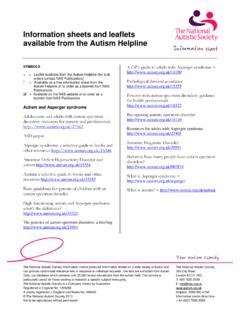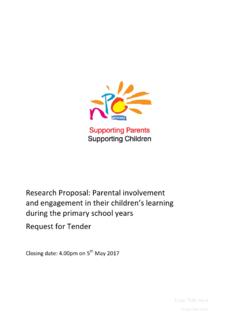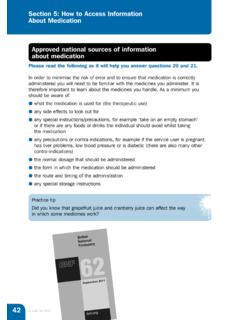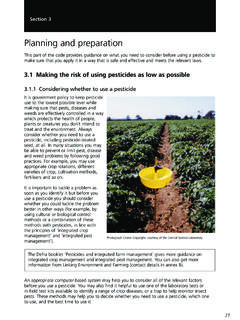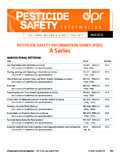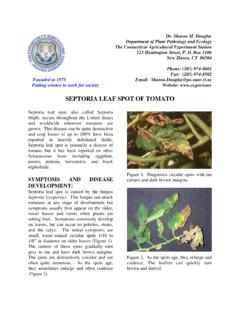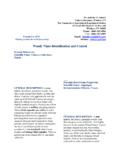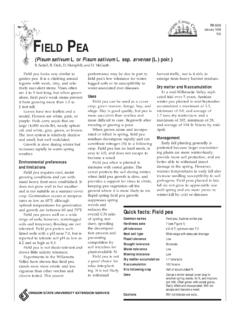Transcription of Safe use of cleaning substances in the hospitality industry
1 Page 1 of 4 Health and Safety ExecutiveHSE information sheetCatering information Sheet No 22 IntroductionThis information sheet was produced by the hospitality and Catering industry Liaison Forum, which has members from trade and professional associations, unions and enforcement authorities. Members associations are free to reproduce and distribute this guidance to catering establishments. The guidance is issued by the Health and Safety guidance is principally aimed at employers in the hospitality industry .
2 It also provides advice for employees when handling hazardous substances . The industry uses many different types of hazardous cleaning substances . They include washing-up liquids, dishwasher detergents and rinse-aids, drain- cleaning products, oven cleaners, disinfectants, toilet cleaners, bleach, sanitisers and information sheet will be relevant to you if you or your staff use any hazardous cleaning substances . By following the guidance, you can reduce the risk of accidental injury or ill health at are the health risks?
3 The most common risks are likely to be through the substances contacting the skin or eyes, breathing in or swallowing cleaning cleaning substances are hazardous because they are corrosive and can cause skin and eye burns if splashed onto the body. Without proper controls, some may cause dermatitis (dry, sore, flaky skin) or other skin irritations, asthma and breathing is highly unlikely that any adult would ever think of drinking a cleaning substance intentionally, but it is still common to find food or drink containers being used to store hazardous cleaning substances .
4 This should not be the face, eyes or skin after handling a cleaning substance can cause irritation, inflammation or chemical substances can cause breathing problems if oversprayed, used without adequate ventilation or sprayed onto hot surfaces, eg improperly used oven can also be adverse chemical reactions when substances are mixed, for example cleaning products containing bleach mixed with acidic toilet cleaners or ammonia will give off harmful risks include accidental splashes to the skin and eyes while cleaning substances are being poured from one container into another, or from spillages while being carried in open containers.
5 There may also be manual handling risks if the containers are heavy or bulky (for further information see Preventing manual handling injuries to catering staff).What the law saysThe Control of substances Hazardous to Health Regulations 2002 (COSHH) require employers to: Assess the risks from working with hazardous substances . This will include any arrangements to deal with accidents, incidents or emergencies, such as those resulting from serious spillages. The assessment must also include the health and safety risks from storing, handling or disposal of any of the substances .
6 Prevent, or if this is not reasonably practicable, control the exposure to such substances . Provide staff with information , instruction and training on the risks and the precautions the employer has taken to control these risks, eg providing appropriate protective gloves or appropriate eye have a duty to take reasonable care for themselves and others who may be affected by their actions and to cooperate with their employer in complying with their legal use of cleaning substances in the hospitality industryHealth and Safety Executive Page 2 of 4 Guidance for employersGather information about the substances , the work and the working practices List all the hazardous substances used.
7 Find out who could be exposed and the risks to health Find out the chance of exposure occurring, how often exposure is likely to occur, what level of exposure could happen and for how long. Conclude what risk is posed by the existing and potential what needs to be done Consider whether there is a need to use each substance in the first place. Stop using those that are not required. For each of the remaining substances and for any new cleaning substances you later consider, ask your supplier if this is the safest product available or if there is a safer alternative, which you should use if it is available.
8 Ask your supplier if you can purchase diluted products in smaller containers that will be easier to use. Consider where and how the substances are used or handled. Avoid pouring from and using bulk containers, as these can be heavy and hard to hold. Minimise handling, eg by using appropriate syphons, pumps etc, smaller containers and lidded containers when carrying solutions, especially if floors are wet or slippery. Keep substances in their original labelled containers where possible. If decanting, ensure that the decanting containers are made of a suitable material, are clean and clearly marked with the manufacturer s instructions for use.
9 The label should clearly identify the hazards of the substance. This will help prevent any confusion about the contents. Consider safe storage arrangements, which should be away from heat, sunlight, foodstuffs and members of public, especially children. Containers should all have lids and be clearly labelled. cleaning and disinfecting substances should be securely stored. Always check manufacturers storage instructions, as some products may need to be stored separately from others. Have procedures in place to clear up spillages.
10 Make sure all your employees are informed, trained and supervised in using cleaning substances . It will not be enough just to issue safety data sheets; you must make sure your employees understand the hazards and the control measures needed to control any risks. Take into consideration any of your staff who do not have English as a first language. You must make sure that they clearly understand. Posters or graphics can help as reminders of how to carry out the job safely. Remember to consult employees and their safety representatives about health and safety issues, including using cleaning substances .










